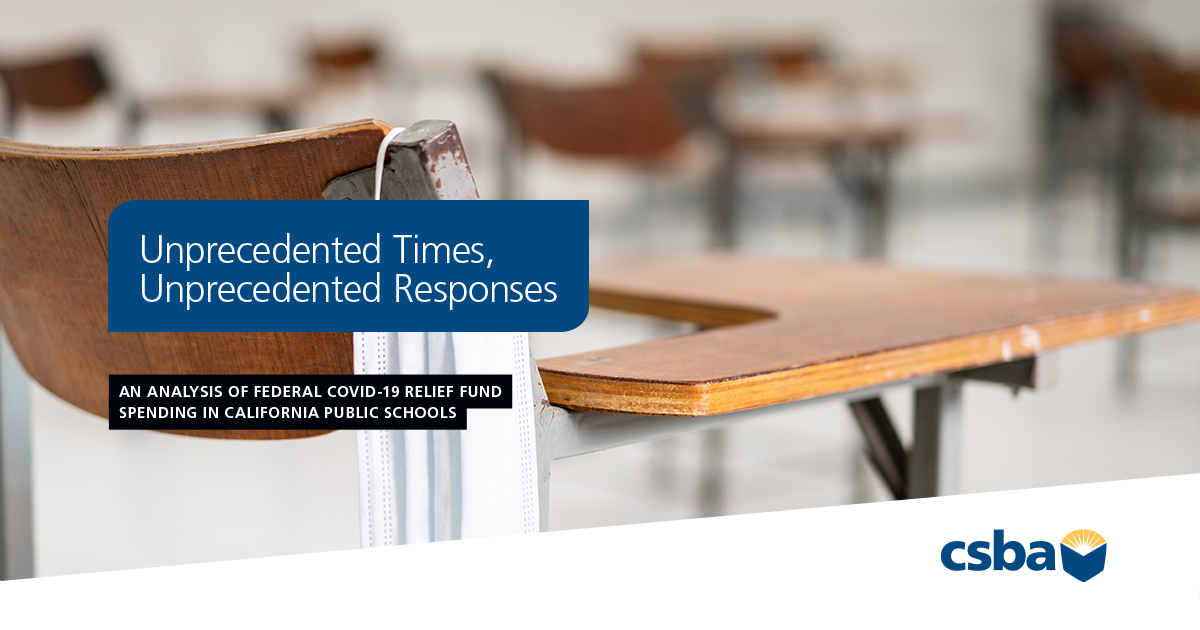By Jeremy Anderson
CSBA has been monitoring how local educational agencies are using COVID relief funding and issued its first report on the progress of spending federal aid in June 2022. Sept. 30, 2022, marked the first significant deadline associated with the federal COVID-19 emergency aid packages, the Elementary and Secondary School Emergency Relief (ESSER I) fund and the Governors’ Emergency Education Relief (GEER I) fund. By that date, LEAs had to reserve the remainder of their funds in the first packages to be spent no later than Jan. 30, 2023.
In light of this milestone, and because the California Department of Education (CDE) released fall expenditure reports for all ESSER and GEER packages, CSBA has updated its analysis on the spending progress of school districts and county offices of education (COEs). These funding packages were not just historic in their amount — but also in the challenges they were created to address.
What is the spending progress of school districts and COEs?
School districts and COEs have spent nearly all of their $1.4 billion ESSER I and $338 million GEER I allocations, which expire in January 2023. Statewide, these LEAs have spent about 99 percent of their ESSER I allocation and 97 percent of their GEER I allotment. Looking at every school district and COE across the state, 99 percent have spent between 81 and 100 percent of their allocated funds as of September 2022. The progress of spending these funds is encouraging because states must return any unspent aid to the federal government.
ESSER II ($6.7 billion to California) and III ($15.1 billion to California) also saw impressive spending progress over the past quarter. These packages have deadlines in 2024 for ESSER II and 2025 for ESSER III. The percentage of ESSER II expenditures statewide jumped from 65 to 71 percent. The amount of money spent of all allocated ESSER III funds doubled from 9 to 16 percent. This progress in the later ESSER packages is promising because it shows that as LEAs wind down spending in earlier packages, they have increasingly turned to funding with later deadlines.
What spending categories are LEAs prioritizing?
Like other reporting periods, LEAs have been spending significant portions of ESSER funding in broader legislatively allowed categories, such as “resources for schools” and “other activities necessary to maintain operations.” These categories give LEAs flexibility in their spending decisions as the challenges presented by the pandemic have changed over time. Despite that, expenses related to educational technology have persisted as a top area of spending across all ESSER and GEER packages. In ESSER II and III, LEAs have reported higher percentages of expenses related to learning recovery. These expenses currently make up over 20 percent of all ESSER III spending.
As with previous releases, the spending data for all packages reflect what LEAs have already spent, not what they have earmarked to spend. For deeper insights into the priorities, spending strategies and implementation challenges of COVID relief funding, read CSBA’s second report on emergency aid, which contains survey data on these topics from a representative group of 239 LEAs across the state.
School board members need to be aware of the timelines associated with these federal funding packages. It is wise to periodically revisit the district’s spending progress to ensure it is in line with the packages’ timelines. That also provides an excellent time to review the district’s priorities with emergency relief spending, using data to evaluate the impact of these programs and discussing whether there are other worthwhile local initiatives on which to spend relief funding.
The Department of Education released a more detailed frequently asked questions guidance in early December that may address questions concerning where a board can designate funding.
While reviewing spending progress and evaluating priorities, governance teams should continue communicating these with their communities. Frequent communication can create a sense of transparency, trust and a greater understanding of the spending decisions of your LEA.
Jeremy Anderson is an education policy analyst at CSBA.





